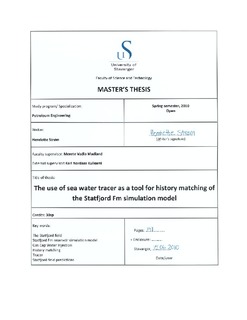| dc.description.abstract | In this study, the Statfjord Fm reservoir simulation model was set up to track injected sea water. The sea
water itself thereby forms a tracer in the simulation model. This sea water tracer was included with the
intent of comparing modeled sea water production with observations. The observed data was the sea
water cut (fraction of sea water in produced water), calculated from the concentration of sulphate and
magnesium in produced water. Comparisons of observations and model results have been used to
further history match the model, by analyzing both the sea water cut and the breakthrough times of sea
water in production wells.
The sea water cut match for some wells was found to be unsatisfactory, indicating a potential for
improvement of the simulation model. Analysis of these results provided information about flow
patterns in the reservoir, and indicated presence of additional faults and regions where permeability
might be different from that used in the model.
The objective of this study was to improve the sea water cut match in the model, for a selection of
Upper Statfjord producers. Statfjord A wells and Statfjord B wells north of the F‐11 fault were
considered when history matching. These regions were prioritized as most of the upflank water injection
took place there.
The first attempt to improve the sea water cut match focused on the relative permeability of water, as
water breakthrough times are sensitive to changes in water mobility. In the model, most producers had
sea water breakthrough too late, indicating that increased water mobility could improve the match.
After implementing a new water relative permeability curve, the sea water cut match was improved, but
at the cost of a too high water production volume. To achieve a satisfactory match, additional changes
were also applied, mostly in the form of modifying the transmissibility of existing faults, introducing new
faults, and by changing permeability in selected layers to encourage fingering of water.
Upflank producers are close to the injectors, and the modeled sea water cut was often too high. Further,
the modeled breakthrough times for most downflank producers were too late, indicating that the model
had underestimated the degree to which injected water could move downflank. Upflank wells could not
be matched on sea water breakthrough times as sea water was in place at the start of production.
Nevertheless, the SWC match has been generally improved. The sea water breakthrough times and the
sea water cut for downflank producers have improved significantly.
This study has been the first step in a process to consider injected sea water when history matching the
Statfjord Fm model. Because only some of the Statfjord Fm producers have been considered,
discrepancies may have been introduced in the match for the remaining wells. This should be accounted
for in any subsequent full match of the field. | en_US |
